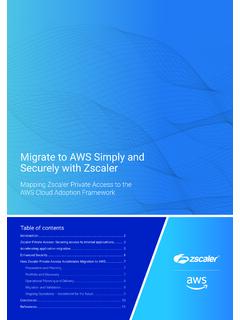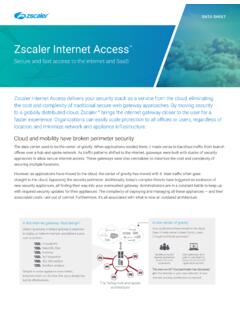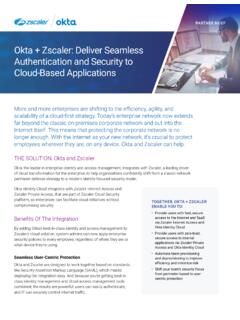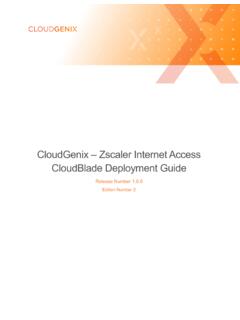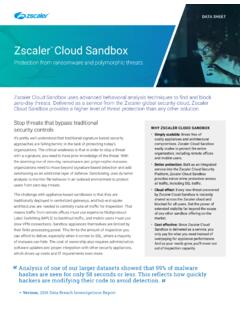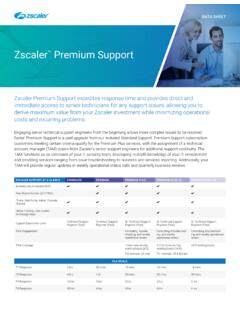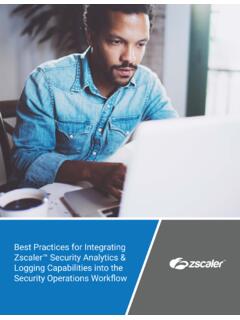Transcription of Transform Source IP-address-based Application Access
1 2020 Zscaler, Inc. All rights Source IP-address-based Application Access with Zscaler1 2020 Zscaler, Inc. All rights enterprises employ Source IP address identification to control Access to applications . But when those organizations adopt SaaS applications , migrate internal applications out of data centers, and support re-mote work, Source IP address identification becomes less effective as a means to secure Access to corporate way of work has evolved to be cloud-first, device-agnostic, and remote. The means of securing it must evolve too. Enterprise cloud transformation demands new identity- based authorization mechanisms (such as multi-factor authentication, or MFA).For some organizations, the path from IP address -only to MFA with inline proxy security carries high switching costs. IP address controls may be hard-coded in legacy applications , embedded in internal websites as geo restrictions, mandated by regulatory requirements, or simply deeply ingrained in the corporate IT security majority of user work is now done in the cloud or on the internet, often remotely from hotspots and/or on personal devices.
2 Source IP address identification by itself is no longer a reliable nor enforceable security control for governing Access to enterprise resources. Zscaler protects the new way of work. This white paper outlines use cases, deployment considerations, and best practices for layering existing Source IP address iden-tification controls with Zscaler s state-of-the-art, multi-tenant security 2020 Zscaler, Inc. All rights history (and limitations) of IP- address controlsRestricting Access to applications or resources based on IP address is a control conceit from an era when users and applications both sat within a perimeter defense. The IP address number identifies the host device seeking Access to the Application or resource over a corporate network. The security challenge is basic: Is this device s IP address within an acceptable set range of numeric values? If yes, lower the draw-bridge. If no, don t answer the such an enterprise environment, IP addresses are classified into so-called security zones, in which each zone has an assigned level of security sensitivity.
3 An enterprise device can then Access resources based on the privileges afforded to its particular zone. A zone range may be discontinuous, and some host devices might be assigned to a default security zone assuming the interface is not already explicitly associated with an existing security address controls rely on whitelisting and blacklisting . To allow Access , an Application or service com-pares Source IP address number of the inquiring device to approved list of numbers ( , within an au-thorized security zone), also known as a whitelist, and based on the result of the comparison, allows, denies, or challenges the Access request. If challenged, the host device may have to provide additional authorization details. (In legacy data center environments, such challenge capability is atypical: Access is usually determined solely by IP address .) If the host device is rejected, its number is blacklisted.
4 (Note that blacklisting also works the other way: IT security may restrict Access to a specific URL or IP address range as a destination due to security risk, real or perceived.) Source IP address - based Access controls are fairly easy to implement. If only they were effective on their own. When it comes to securing the new enterprise way of work, Source IP address - based Access controls have limitations:Poor authentication: As an identity mechanism, IP address controls recognize a device, not the device s user. (This prevents the Application of least-privilege permissions, a key component of Zero-Trust policies.) If any device within an authorized security zone is compromised, everything accessible to that device is vulnerable to : IP address management is exceedingly complicated. Improperly configured IP ranges can inadvertently lock out Access to admin 2020 Zscaler, Inc. All rights for remote work: When used for geo-restriction ( , specific ranges assigned based on geog-raphy), Source IP address controls fail when users Access resources from new, out-of-geo performance: Source IP restrictions force users to VPN in from remote work locations just so they can egress to the internet via a known IP.
5 That backhauling adds to compromise: IP addresses can be easily spoofed. One common attack-vector scenario: An open (or weak WEP encryption based ) Wi-Fi network in an allowed address space can easily be exploited to hijack connections and gain that anchor Source -IP addresses to control Access to applications and resources must reinvent their approach to protect the new (cloud-first, device-agnostic, remote) way of work. (Their employees are working that way already.) But mov-ing beyond Source -IP address controls as an exclusive means of securing Access isn t trivial, and such efforts can incur switching s cloud- based security services can pair with Source -IP address security anchoring, acting as a layer in a cloud-security service stack to solidify an enterprise s threat-protection posture; as well as provide a migration path to a stronger security + Source -IP controls: a practical approach to layered securityZscaler was founded on the notion that cloud and mobility would disrupt traditional network and security architectures.
6 That disruption is evident in the need for enterprises to move forward from Source -IP ad-dress- based security controls to identity- based secure the new way of work, enterprise IT leaders must start with an assessment. To what extent does the organization depend on Source IP address as an Access control mechanism? What s the gap between existing and ideal security state? And what evaluation criteria (cost, complexity, improved security posture metrics) will help sell such an initiative internally?Zscaler s cloud- based security services can pair with Source -IP address security anchoring, acting as a layer in a cloud-security service stack to solidify an enterprise s threat-protection posture; as well as provide a migration path to a stronger security 2020 Zscaler, Inc. All rights evaluation is the initial stage of enterprise security strategic planning:1. Audit use of Source IP addresses to allow/restrict Access to internal and external Can Source IP address control use be modified?
7 If so, what s the scope of those modifications (on a case-by-case basis)? b. Are approved-security-zone IP addresses mandated by an outside third party (like a government regulator using IP addresses to determine in-geo Access )?c. Can internal sites with embedded legacy IP- address coding be updated to more modern (and dy-namic) authentication mechanisms like MFA?2. based on assessment findings, prioritize a security Zscaler + Source IP address controls: Which enterprise operations should be layered with Zscaler inline-proxy cloud- based security?b. Zscaler-only: Which enterprise operations can be modified to ease dependence on IP addresses as a control mechanism?Zscaler Internet Access (ZIA) secures user internet egress, protecting an enterprise from both external threats (phishing, ransomware, or other malware attacks) and data exfiltration. Zscaler Private Access (ZPA) secures internal traffic to applications and resources, protecting an enterprise from unauthorized Access to corporate data.
8 (Note that the two services are sold and administered separately, though many Zscaler customers deploy both ZIA and ZPA.)In implementation, ZIA and ZPA work with Source -IP address controls in different and Source -IP address - based controlsEnterprises use ZIA to (among many other functions) progress from legacy internet egress methods to local internet breakouts. In the legacy model (hub-and-spoke corporate network with castle-and-moat pe-rimeter security), users connect often via VPN to a central web gateway, and then move from there on to the internet. Traffic is backhauled, gateways become bottlenecked, and connectivity performance that with the ZIA model, where users go online at the nearest internet onramp, and enjoy direct, secure, fast, and optimized Access to internet resources, including SaaS applications like Office 365. In this new model, the conceit of connecting to a corporate network (and then to the internet) goes away.
9 ZIA acts as an inline proxy: Zscaler terminates the original connection from the customer s device or network and initiates a new, direct connection to the destination content server on behalf of the user. The Source IP address seen by the content server is a public-egress IP address from the Zscaler data center, and not the 5 2020 Zscaler, Inc. All rights IP address of the enterprise user s ZIA proxy function allows Zscaler to inspect all content traversing from client to server and back, and protect the user if the user visits a potentially-malicious (or compromised) destination. The use of Zscaler IPs on the egress acts as a form of network address translation (NAT) protection, shielding device IP ad-dress from the destination content server. (Note that device IP address is inserted into the XFF header.)For enterprises that still rely on Source -IP address whitelisting, NAT address -masking can interfere with Application Access , since a destination Application won t recognize a Zscaler IP address as being within an acceptable security zone ControlCloud FirewallURL FilteringBandwidth ControlDNS ResolutionThreat PreventionCloud SandboxDNS SecurityProxy (Native SSL)Advanced Threat ProtectionAccess ControlCloud DLPE xact Data MatchCASBFile Type ControlsUnprecedented VisibilityLogs only written in memory and forwarded to a logging cluster in a geography of your choiceLog streaming to your SIEM / SOCF igure 1.
10 ZIA offers direct, secure, fast, and optimized Access to internet resources, including SaaS applications like Office 2020 Zscaler, Inc. All rights and Source -IP address - based controlsZscaler Private Access (ZPA) connects users to internal private destinations through policy-defined tun-nels between Z-app, Zscaler s end-point agent, and Application connectors, VMs situated next to internal applications . ZPA steers enterprise traffic to internal resources. The connection does not egress through ZIA, but instead routes to an Application connector (from where it then connects to the appropriate internal resource). Since the Application connectors reside in a customer s own data center or public cloud (say, AWS, Azure, or GCP) the destination resource ( , internal Application or content server) can see the user s assigned or whitelisted IP does require Z-App as an endpoint control for non-web applications , and it allows browser- based ac-cess without Z-App for internal web applications .

